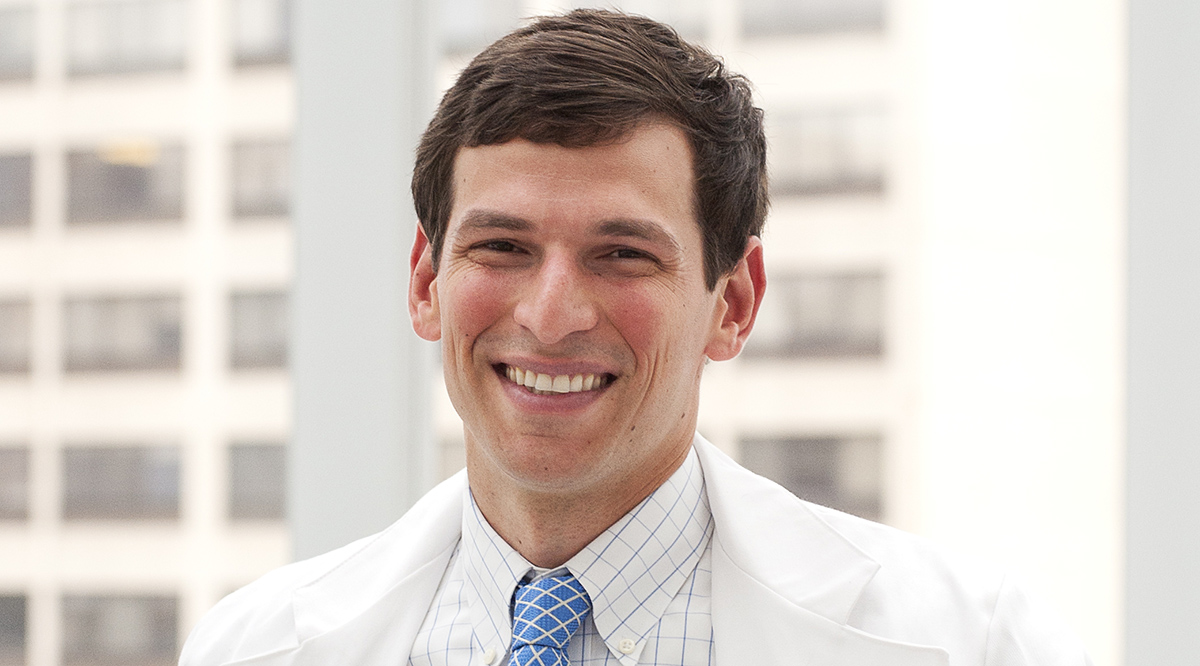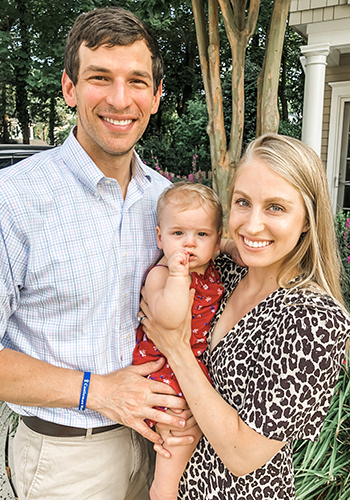
Editor’s note: The opinions expressed by the author do not necessarily reflect the opinions of the AAMC or its members. The author’s book, Chasing My Cure: A Doctor’s Race to Turn Hope Into Action, is being released today by Ballantine Books.
I don’t remember much from when I had my last rites read to me in 2010 at 25 years old. I was incapacitated and suffering from failure of my liver, kidneys, and other vital organs. I do remember it was dark and I was scared to die. As a third-year medical student, I had never witnessed such a rapid decline in anyone’s health, let alone my own. After weeks in the ICU, I had finally been diagnosed with idiopathic multicentric Castleman disease (iMCD), and my doctors had started me on chemotherapy in a last-ditch effort to keep me alive.
Fortunately, the chemotherapy kicked in just in time to save my life. Unfortunately, I would go on to have four life-threatening relapses over the next three years.
I would soon learn that iMCD is the deadliest subtype of Castleman disease, which is diagnosed in approximately 5,000 new patients in the United States each year — roughly the same number as ALS. Sitting at the intersection of lymphoma and autoimmune diseases, iMCD involves a hyperactivated immune system that shuts down vital organ function for no known reason. Approximately one-third of patients die within five years of diagnosis, and another third die within 10 years. iMCD is so deadly because inadequate funding and research means it’s poorly understood. In fact, there were no Food and Drug Administration (FDA)-approved treatments, no diagnostic criteria, no treatment guidelines, and no coordinated research effort at the time of my diagnosis.
The problem is that, for some rare diseases, no one knows anything, and nothing is being done to change that.
iMCD is certainly not alone in this. In fact, of the 7,000 rare diseases that affect 30 million Americans, 95% do not have a single FDA-approved therapy. This is partly a result of inadequate incentives to match the high research and development costs for many rare diseases and the challenges of recruiting patients for rare disease trials. In light of this, we medical professionals recognize that none of us know all there is to know about all diseases. But that’s not really the problem. The problem is that, for some rare diseases, no one knows anything, and nothing is being done to change that.
Understandably, patients with diseases like mine often feel hopeless. But my journey from medical student to critically ill patient to physician-scientist and patient advocate has taught me a lot. I’ve learned that there is reason to be hopeful, but only if we turn our desires for treatments and cures into action. I’ve learned that hope should not be a passive concept. It’s a choice, and it can be a powerful force.
When hope inspires action in medicine, where technologies to address diseases are more advanced than ever and hundreds of FDA-approved drugs could possibly be repurposed for other conditions, seemingly miraculous results are possible.
Fighting back
“If I survive this, I’m going to dedicate the rest of my life — however long that may be — to advancing treatments and curing this disease,” I told my family and girlfriend Caitlin between beeps from my IV pole as seven chemotherapies infused into my bloodstream.
It was now 2012 and a year since my most recent brush with death. I was in the midst of a relapse on the only drug in development for iMCD and had just learned that there were no more leads. Nothing — no reason whatsoever to be hopeful. But I wasn’t deluded when I made that promise. I knew it was unlikely that I’d make progress in time to save my own life, but I wanted to go out swinging.

I returned to medical school on a mission. I began by studying the rare disease space and how progress usually is made. I learned that rare disease foundations typically first raise funds, then invite researchers to propose ideas for how they would use the funding, and finally select the best applicants. Basically, the hope is that the right research idea will be proposed by the right applicant with the right skillset at the right time. This works when there are hundreds or thousands of applicants, but not when there are three or four as is the case with many rare diseases. This is like waiting for the stars to align.
Partnering with my mentor Arthur Rubenstein, MBBCh, and inspired by my Wharton classes (I was doing a joint MD-MBA at the time), we tried to reimagine how rare disease research could be conducted. Our vision was for what we decided to call a Collaborative Network Approach, and in 2012 we founded the Castleman Disease Collaborative Network (CDCN) together with my doctor, Frits van Rhee, MD, PhD, in order to spearhead this approach for Castleman disease.
Through the CDCN, we built a community of over 400 physicians, researchers, patients, and loved ones, and we invited them to crowdsource the most important research questions and ideas into a prioritized agenda. Then, my medical school classmates, some iMCD patient volunteers, and I began recruiting the best researchers to perform high-priority studies, raise funds, and procure samples. We identified the right research ideas, the right researchers, the right materials, and the needed funding to make rapid advances. In other words, we aligned the stars.
The hope is that the right research idea will be proposed by the right applicant with the right skillset at the right time. … This is like waiting for the stars to align.
In parallel, I began conducting laboratory and clinical research into iMCD, mostly working on the samples that were easiest to access: my own.
Although a lot of work remains, we have made tremendous progress in understanding, diagnosing, and treating iMCD, including developing the first-ever diagnostic criteria and treatment guidelines. We’ve also managed to generate insights into iMCD mechanisms and the immune system generally. Unfortunately, none of this progress had been made when I had my fourth near-deadly relapse in 2013.
My battle
I had recently gotten engaged to Caitlin, graduated from medical school, and begun fully focusing on my MBA coursework when everything came rushing back: the intense fatigue, crashing blood counts, and organ failure. I was also back in the hospital.
I had now failed to respond to every drug that had ever been tried for my disease, and I was approaching the lifetime maximum of the seven-agent chemotherapy combination that had been giving me brief stints of remission before each withering relapse. Chemotherapy saved my life again, but I knew that another relapse was on the horizon and I was running out of options. I needed to identify a drug that could prevent iMCD from coming back.
Developing a new FDA-approved drug takes around 10 to 15 years and more than $1 billion. Obviously, I didn’t have that kind of time or money. Fortunately, there are more than 1,500 drugs that are already FDA-approved for at least one condition. Many diseases share similar dysfunctional cell types, genes, cellular signaling pathways, and proteins, so I understood that many of these drugs could theoretically be used off-label for treating diseases with no other options, like iMCD.
My task became to pore over thousands of pages of my medical records and data from lab experiments I performed on my own samples. I needed to identify a cell type, a gene, a communication line — something — that was dysregulated in me that could be targeted with an available treatment, regardless of what disease the medication was originally developed to treat.
Thanks to a combination of hyperfocus and support from Caitlin, I discovered that my T cells were activated and an immune system molecule called VEGF was highly elevated. Further analyses of my blood revealed a potential link between the two: a cellular communication line called mTOR that’s involved in both T cell activation and VEGF production seemed to be hyperactive. A final experiment confirmed my suspicion.
My task became to pore over thousands of pages of my medical records and data from lab experiments I performed on my own samples.
The best part about learning that mTOR was activated is that there is a safe and potent inhibitor of it called sirolimus that was originally approved for kidney transplantation. It had never been used before for iMCD and there were no guarantees that it would work, but my doctors and I decided to try it.
Promise for the future
Today marks 68.16 months since my last relapse. This is about nine times longer than my average remissions before starting sirolimus. The .16 is important. I’ve learned that I can’t round up — I may relapse tomorrow. But I also refuse to round down because my team of warriors and I worked really hard for every day that this treatment made possible.
Importantly, this remission has allowed me to marry the love of my life, Caitlin. It also gave me more time to research iMCD and discover that there is increased mTOR activation in others with my disease. That discovery has led to sirolimus helping several additional iMCD patients (but not everyone who has tried it), and I recently launched a clinical trial of sirolimus to investigate its efficacy. It also enabled Caitlin and me to have a daughter, Amelia, one year ago. I never thought I would experience this when I reflected about my life on my deathbed all five times. In addition, I have a book, Chasing My Cure: A Doctor’s Race to Turn Hope Into Action, coming out. My wish is that it will inspire others to reflect on their hopes and then turn them into action.
I am beyond grateful for where we are today and for all the amazing individuals who have helped us get here. Still, much work remains for iMCD and many other diseases that so desperately need treatments and cures.
The good news is that the steps we have taken for iMCD are repeatable. They involved 1) building a collaborative network to crowdsource high-impact research, 2) leveraging data generated from the high-impact research studies to identify potential novel targets for existing drugs, and 3) testing these already-approved drugs for new uses.
How many of the approximately 1,500 drugs already FDA-approved for at least one disease may be treatments or cures for many of the 7,000 other diseases with no approved treatments?
In fact, we have partnered with the Chan Zuckerberg Initiative to try to spread our collaborative network approach (step 1) to other diseases. In addition, rare diseases need governmental leadership such as previously proposed legislative changes and private sector efforts to incentivize researching and repurposing existing drugs (steps 2 and 3). As I learned firsthand, repurposing drugs is faster and far more economical than starting development from scratch since these drugs can be used right away off-label — and with proper clinical studies, they can more quickly demonstrate both safety and effectiveness.
How many of the approximately 1,500 drugs already FDA-approved for at least one disease may be treatments or cures for many of the 7,000 other diseases with no approved treatments?
I know that so many of us hope that many such drugs are hiding in plain sight. Let’s do everything we can to turn our hope into action. Patients like me are waiting.
David Fajgenbaum, MD, MBA, MSc, is an assistant professor of medicine at the University of Pennsylvania, executive director of the Castleman Disease Collaborative Network, and author of Chasing My Cure: A Doctor’s Race to Turn Hope Into Action.
